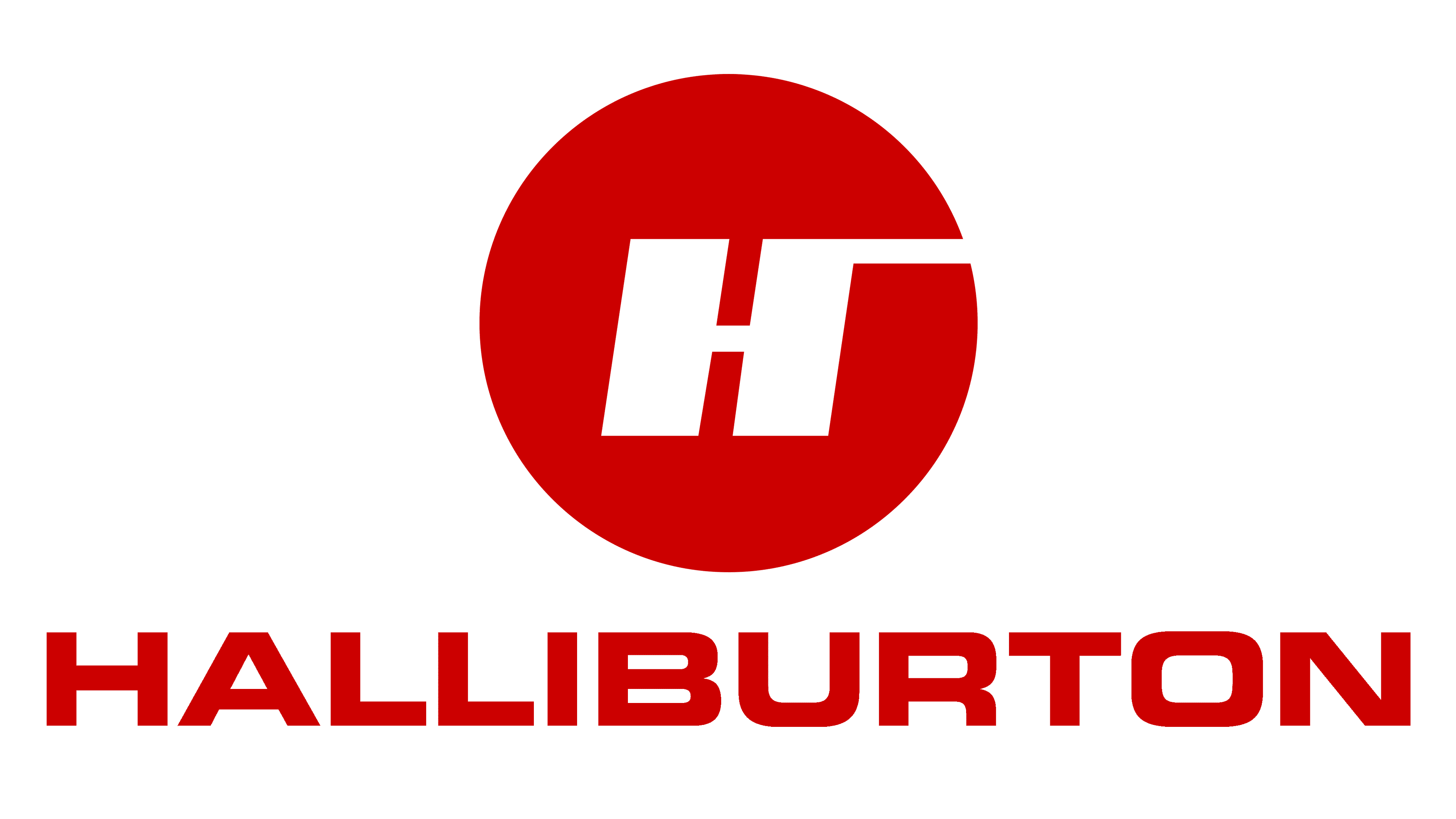Halliburton Logo
Halliburton, a major global player in the energy industry, specializes in oil field services. Renowned for its expertise in drilling, evaluating hydrocarbon reservoirs, and managing geological data, Halliburton actively operates in various international markets. Its ownership is public, with shares traded on stock exchanges, making it a company collectively owned by its numerous shareholders. Halliburton’s influence extends across significant oil-producing regions, reflecting its status as a key entity in energy services.
Meaning and history

Founded in 1919 by Erle P. Halliburton, the company began as a humble well cementing business in Oklahoma. Halliburton’s initial breakthrough was a pioneering cementing technique, enhancing oil well construction and setting a trajectory for innovation.
By the 1930s, Halliburton had crossed national borders, initiating operations in Venezuela. This marked its first step as a global entity, signaling the beginning of an expansive multinational journey.
The post-World War II era saw Halliburton diversify its offerings, branching out from cementing to drilling, engineering, and construction services. The acquisition of Brown & Root in the 1960s further broadened its portfolio, stepping into construction and engineering.
The latter half of the 20th century was characterized by strategic mergers and acquisitions, reshaping Halliburton’s business landscape. Notably, the 1984 merger with Geophysical Service Incorporated and the 1998 acquisition of Dresser Industries were pivotal, enhancing its exploration and production capabilities, though it later divested some Dresser segments.
In the 2000s, Halliburton navigated through controversies, including operational allegations in the Middle East and environmental concerns. Nonetheless, it remained focused on innovation, particularly in digital and advanced oil and gas exploration technologies.
Halliburton’s ownership has been in the hands of public shareholders since its 1948 stock market debut. Its diverse shareholder base includes a mix of institutional and individual investors, reflecting its wide-reaching corporate influence.
Halliburton is a dominant force in the global oil field service sector. Its legacy, characterized by strategic acquisitions, technological innovations, and international expansion, cements its role as a pivotal player in the dynamic energy industry.
What is Halliburton?
Halliburton stands as a titan in the energy services sector, specializing in a broad array of products and services for oil and gas exploration and production. Renowned for its innovative technologies and global operations, the company plays a pivotal role in shaping the modern energy landscape. Founded in 1919, Halliburton’s century-long journey reflects a legacy of adaptation and leadership in the evolving world of energy.
1919 – 1938
The logo is a text-based design, primarily typographic, showcasing the name “Halliburton” in an elegant serif font that conveys a classic and professional feel. The font’s elaborate capital ‘H’ adds a distinctive touch, while the rest of the letters maintain a traditional look. The words “Oil Well Cementing Co. Shop and Garage” are arrayed beneath in a smaller, simpler type, suggesting the company’s original business focus. The overall design is monochromatic, suggesting a vintage or historical origin, and the straightforward layout reflects a no-nonsense approach to branding.
1938 – 1946
This logo is a detailed emblem featuring the Halliburton name with a prominent serif typeface, flanked by illustrations of vintage trucks, symbolizing the company’s operational heritage. Unlike the previous, simpler logo, this one includes “Patented Process” and “Duncan, Oklahoma,” highlighting the company’s proprietary technology and location. The visual elements, notably the trucks, add a narrative of practicality and industry to the identity.
1946 – 1954
This logo merges the Halliburton name in bold, block serif letters with a dynamic winged emblem, encapsulating a global map and vehicles, indicative of worldwide reach and mobility. It departs from the earlier designs by incorporating motion and global operations, contrasting the previous logos’ stationary and local focus. The winged graphic suggests speed and expansion, aligning with the company’s growth and broadened horizons during this era.
1954 – 1993
This logo features the Halliburton name in a strong, serif typeface, overlaid on intersecting red circles with a streamlined wing motif, suggesting swift movement. It simplifies the previous design by focusing on geometry and color, conveying energy and precision. The red and black contrast sharply, emphasizing a modern, more stylized corporate identity.
1993 – 1997
The logo portrays a minimalist design with the letter “H” in a bold white font inside a red circle, connected to the full name “Halliburton” in a clean, sans-serif typeface. This modern rendition strips away previous complexities, opting for a stark, high-contrast color scheme and simplified shapes, presenting a crisp, contemporary corporate image. The design shift reflects a trend towards sleek, scalable branding.
1997 – 2002
The logo features a stylized “H” within a red circle, paired with the company’s name in an italicized, bold sans-serif font. This design further simplifies the previous iteration, maintaining the color scheme while streamlining the font and enhancing the name’s dynamism through italicization. It continues the trend of modern, minimalist branding.
2002 – Today
The logo is a study in minimalism, sporting a bold ‘H’ within a red oval, above the company’s name in red, capital, sans-serif letters. This emblem exemplifies modern design principles, using color and form to create a clean, instantly recognizable corporate symbol. The use of red symbolizes energy and strength, fitting for a company in the energy sector.

















